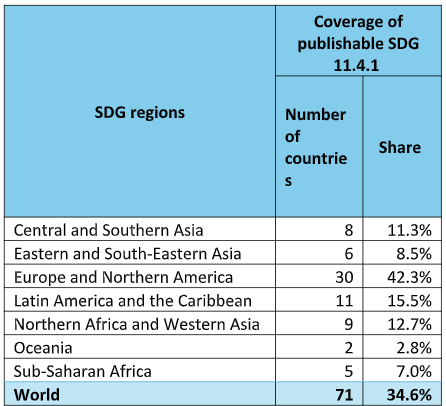Culture and R&D November 2024 Data Refresh – with updated stats and indicators
Share
18/11/2024
The UNESCO Institute for Statistics (UIS) is pleased to announce its November 2024 Data Refresh for expenditure on culture and natural heritage (SDG 11.4.1); and research and development (R&D) with updated data and indicators to monitor progress towards the SDG 11.4.1 and SDG 9.5 respectively.
SDG 11.4.1 on expenditure on culture and natural heritage:
Updated national data are available for SDG 11.4.1 (Total per capita expenditure on the preservation, protection and conservation of all cultural and natural heritage) and its disaggregation (by source of funding, type of heritage and level of government) for the reference year 2022 (or latest available). Data were collected from the UIS 2023 Survey of Expenditure on Cultural and Natural Heritage.
The number of countries of the UIS global database for SDG 11.4.1 and its disaggregation has reached 71 countries, more than double than the number available in 2021. For the 2023 data collection, new countries from Northern Africa and Western Asia reported data for the first time. Table 1 shows the coverage of the UIS SDG 11.4.1 data published in the November 2024 data release by SDG regions. Europe and North America represents 42.3% of countries reporting data followed by Latin America with 15.5% of countries reporting and Northern Africa and Western Asia with 12.7%. Oceania and Sub-Saharan Africa are the regions with the lowest representativity with 2.8% and 7% respectively of countries reporting data.
Table 1: Coverage of publishable data on SDG indicators 11.4.1 in November 2024

An increasing number of countries are reporting the data to calculate the total SDG 11.4.1 from 10 countries for 2018 to 25 for 2021 (See Figure 1). It demonstrates that countries are investing to improve the coverage of the indicator. While countries from Europe and North America represents less than 50% of the data published as explained above, they represent 64% of countries that can calculate the complete indicator, followed by countries from Latin America and the Caribbean (LAC) with 12%. Countries reporting from the LAC region are from only Latin America countries.
Figure 1 shows that the public and private investment for safeguarding cultural natural heritage varies on a large scale from 1 USD Purchasing Power Parity (PPP USD) per capita to more 515.8 PPP USD per capita. It shows also that the investment is not necessarily dependent on the level of wealth of a country as it shows a great variety of USD per capita invested for similar level of GDP.
Figure 1: SDG 11.4.1: Expenditure (public and private) spent on cultural and natural heritage (per capita and in constant PPP USD) and GDP per capita (in constant PPP USD) in 2021 or latest year available

SDG 9.5 on R&D:
The data refresh primarily includes new country-level data for 43 countries for the 2022 reference year, for SDG 9.5 indicators (SDG 9.5.1: Research and development expenditure as a proportion of GDP; SDG 9.5.2: Researchers in full-time equivalent per million inhabitants), as well as a set of selected gender-disaggregated R&D indicators. The new data are based on the UIS 2023 R&D Statistics Survey (in particular country submissions received after the main data releasein Spring 2024), as well as new statistics obtained from other UIS partners, notably the Organisation for Economic Co-operation and Development (OECD), and the Statistical Office of the European Union (Eurostat) It also includes updated time series data for the above indicators.
Explore UIS Culture and R&D data and supporting documents:
2024 UIS Culture and R&D data collections:
As the UIS 2024 Survey on expenditure on cultural and natural heritage (SDG 11.4.1) and 2024 Survey of Research and Experimental Development Statistics for SDG 9.5 and are ongoing, countries are encouraged to complete the respective survey questionnaires (which are available on the UIS website at: http://uis.unesco.org/uis-questionnaires) as soon as possible. This will ensure inclusion of the most recent data (for reference year 2023 or the latest available year) in the next UIS main data release for Culture and R&D, tentatively scheduled for March 2025, as well as in international databases and reports, such as the United Nations (UN) SDG Indicators Database, UN SDG monitoring reports, the Global Innovation Index (GII) Report and more.